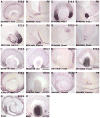Identification of genes expressed preferentially in the developing peripheral margin of the optic cup
- PMID: 19449303
- PMCID: PMC2916742
- DOI: 10.1002/dvdy.21973
Identification of genes expressed preferentially in the developing peripheral margin of the optic cup
Abstract
Specification of the peripheral optic cup by Wnt signaling is critical for formation of the ciliary body/iris. Identification of marker genes for this region during development provides a starting point for functional analyses. During transcriptional profiling of single cells from the developing eye, two cells were identified that expressed genes not found in most other single cell profiles. In situ hybridizations demonstrated that many of these genes were expressed in the peripheral optic cup in both early mouse and chicken development, and in the ciliary body/iris at subsequent developmental stages. These analyses indicate that the two cells probably originated from the developing ciliary body/iris. Changes in expression of these genes were assayed in embryonic chicken retinas when canonical Wnt signaling was ectopically activated by CA-beta-catenin. Twelve ciliary body/iris genes were identified as upregulated following induction, suggesting they are excellent candidates for downstream effectors of Wnt signaling in the optic cup.
2009 Wiley-Liss, Inc.
Figures





References
-
- Acampora D, Mazan S, Avantaggiato V, Barone P, Tuorto F, Lallemand Y, Brulet P, Simeone A. Epilepsy and brain abnormalities in mice lacking the Otx1 gene. Nat Genet. 1996;14:218–222. - PubMed
-
- Ahmad I, Dooley CM, Thoreson WB, Rogers JA, Afiat S. In vitro analysis of a mammalian retinal progenitor that gives rise to neurons and glia. Brain Res. 1999;831:1–10. - PubMed
-
- Araki T, Milbrandt J. Ninjurin, a novel adhesion molecule, is induced by nerve injury and promotes axonal growth. Neuron. 1996;17:353–361. - PubMed
-
- Beebe DC. Development of the ciliary body: a brief review. Trans Ophthalmol Soc U K. 1986;105 (Pt 2):123–130. - PubMed
Publication types
MeSH terms
Substances
Grants and funding
LinkOut - more resources
Full Text Sources
Molecular Biology Databases

